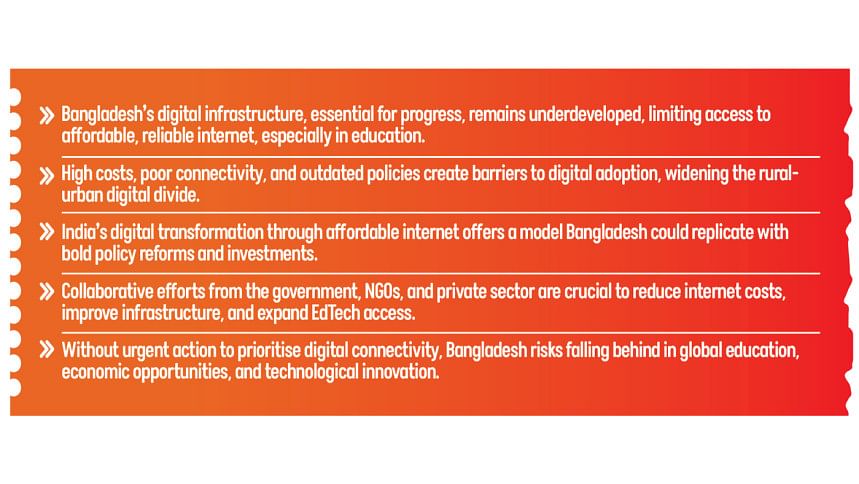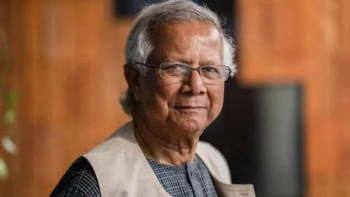Unlocking Bangladesh’s potential through digital connectivity

In the 21st century, the notion of infrastructure has evolved beyond roads, bridges, and railways. The new lifeline for progress is digital infrastructure—specifically, access to affordable and reliable internet. Yet, in Bangladesh, the internet remains treated as a luxury rather than a fundamental utility. This mindset is not only outdated but also a significant impediment to our collective growth. Nowhere is this more apparent than in the education sector, where education technology (edtech) has the potential to bridge gaps that traditional methods have failed to address. But without accessible mobile data and widespread Wi-Fi, that potential will remain untapped.
The case for digital infrastructure in education
Imagine a remote village where trained teachers are scarce or non-existent. In such places, edtech is already proving to be a game-changer, allowing students to access the best teachers and resources through video streaming—both live and recorded. Platforms powered by the internet can deliver high-quality lessons to millions of students at a fraction of the cost of building physical schools or training qualified teachers. Yet, this possibility hinges on one critical factor: digital connectivity.
Shikho's own experience underscores this reality. With 2.5 million registered users across all 64 districts of Bangladesh, including remote villages and islands, the demand for edtech is undeniable. However, we observe that registered users in rural areas engage far less with our platform compared to their urban counterparts. The primary barrier? Internet pricing.
Rural students frequently tell us, "MB shesh", a phrase reflecting how they measure internet usage in megabytes due to high costs. This mindset highlights the friction in access that prevents them from leveraging digital tools effectively. A shift to GB usage as the standard would be transformative—not just for edtech but for all digital services. It would mark a significant step toward bridging the rural-urban digital divide and empowering underserved communities.
Learning from India: the Jio effect
India offers a compelling case study of the transformative power of affordable internet. In 2016, Reliance Jio disrupted the market by offering drastically cheaper mobile data and free voice calls.
The results were staggering. Data usage skyrocketed, and India became one of the world's largest consumers of mobile data, with average usage increasing from 430 MB per month in 2015 to 11 GB per month by December 2019, according to Nokia's Mobile Broadband Index 2020. This surge in data consumption was accompanied by a rapid expansion of internet penetration, as affordable data brought millions of rural Indians online for the first time. The impact extended beyond connectivity; EdTech platforms flourished as companies offering online learning services scaled exponentially, reaching students across both urban and rural areas.
Addressing the digital divide requires a strategic approach focused on reducing the cost of smartphones, mobile data, and Wi-Fi, which have become fundamental public goods. Equally important is investing in rural connectivity by supporting the expansion of telecom networks and fostering greater industry competition among mobile network operators to improve service quality and affordability.
This explosion in connectivity didn't just benefit students. It catalysed behavioral and psychological shifts as people began to integrate digital services into their daily lives. From streaming educational content to accessing government services, the internet became a vital tool for empowerment.
Bangladesh can replicate this success. But it requires bold policy decisions and a collaborative effort between the government, NGOs, and the private sector. The friction in the current system—high costs, poor access, and weak infrastructure—must be addressed.

The friction in Bangladesh's system
Bangladesh faces significant challenges in mobile internet adoption, particularly in rural areas. According to the GSMA's 'The State of Mobile Internet Connectivity 2024' report, only 26% of rural residents own smartphones, compared to 41% in urban areas. This disparity contributes to lower mobile internet usage, with 27% in rural regions versus 43% in urban centers.
Affordability remains a critical barrier. The GSMA report highlights that the cost of devices and data plans disproportionately affects underserved populations, limiting their access to mobile internet services. These challenges are compounded by high taxation on mobile services. The supplementary duty on mobile data has increased from 3% in FY16 to 23% in 2024, making internet access less affordable for the general population.
Another significant friction to smartphone adoption is their price. Instead of making smartphones more affordable, recent government policies have increased taxation on locally produced and assembled devices.
A 2% VAT was introduced for fully locally produced handsets, where previously no such tax existed. For devices manufactured with at least two locally made components, the VAT has increased from 3% to 5%. Additionally, handsets assembled domestically using all imported components now face a 7.5% VAT, up from the previous rate of 5%.
These policy changes have raised the cost of devices, creating additional barriers for low-income families in rural areas who are already struggling with high mobile data costs. Addressing these issues requires a multifaceted approach, including reducing taxes on mobile services, improving the affordability of devices and data plans, and implementing policies that incentivise local production and lower consumer prices.
The role of NGOs, governments, and multilateral institutions
NGOs, donor agencies, and governments have long been involved in improving education in Bangladesh, but much of their focus remains on analog solutions—building schools, distributing textbooks, and training teachers. While these initiatives are valuable, they fail to address the root cause of educational inequality in the digital age: the lack of internet access.
Instead of continuing to invest in fragmented programs, these stakeholders should work toward a unified, strategic agenda aimed at removing the digital divide. Multilateral and bilateral institutions like the World Bank and Asian Development Bank (ADB), alongside NGOs and governments, have the resources to drive systemic change. The focus should not be on subsidies alone but on pooling resources to lower the cost of essential digital infrastructure.
Addressing the digital divide requires a strategic approach focused on reducing the cost of smartphones, mobile data, and Wi-Fi, which have become fundamental public goods. Equally important is investing in rural connectivity by supporting the expansion of telecom networks and fostering greater industry competition among mobile network operators to improve service quality and affordability. In addition, creating strategic partnerships between governments, telecom companies, and development agencies can play a crucial role in reducing infrastructure costs, ultimately making internet access more affordable for underserved communities.
By shifting away from analog interventions and prioritising digital solutions, these efforts can ensure that underserved populations gain access to tools that empower them in education, healthcare, and economic opportunities. Instead of building more analog systems, the goal should be to provide universal digital access and integrate those without connectivity into the digital economy.
Such a collaborative approach can create sustainable, scalable solutions that benefit all stakeholders and ensure that no one is left behind in the journey toward a connected Bangladesh. It would also allow private companies like Shikho, which are providing meaningful digital services that can be considered public goods, to broaden their impact.
Empowering all stakeholders in education
Education technology, like the services Shikho has built, is not just about empowering students—it's a comprehensive solution designed to bridge the demand-supply mismatch in Bangladesh's education system. With only 1.69% of GDP allocated to education, the sector faces chronic resource constraints: too many students, too few teachers, and limited infrastructure. EdTech can address these challenges by providing scalable solutions that benefit all education stakeholders—students, parents, and teachers alike.
For students, EdTech offers access to high-quality resources and teaching, even in resource-constrained environments. But its potential goes far beyond the classroom. Schools can integrate EdTech to power their operations, and teachers can leverage it for training and professional development. Parents, too, can use EdTech to access tools and information that help them support their children's learning journey.
Despite these benefits, many parents and teachers perceive EdTech as unfamiliar or even alien. While students have begun to embrace digital tools, their parents often remain hesitant, and school teachers may not feel comfortable integrating EdTech into their daily routines. This gap is not a lack of interest but a lack of familiarity and accessibility. Digital literacy can only be built through consistent usage, and this requires making internet and digital tools affordable and accessible.
To catalyse this adoption, cost barriers must be reduced. Subsidising mobile data and devices for parents and teachers is a crucial first step. By enabling these stakeholders to engage with digital tools in their everyday lives, we can foster a culture of digital fluency that benefits the entire education ecosystem. When parents and teachers begin to see the tangible benefits of EdTech, their increased usage will drive broader adoption and transform how education is delivered and experienced across Bangladesh.
A call for forward thinking
Bangladesh's current approach to infrastructure is deeply rooted in the past. We prioritise physical highways while neglecting the digital highways that will drive future growth. This mindset must change.
The world is already moving beyond basic internet services to AI-driven innovations, from personalised learning platforms to automated healthcare solutions. If Bangladesh fails to lay the groundwork now, it risks being left behind—not just in education, but in the global race for economic opportunities.
Without affordable and reliable internet, millions of students will remain locked out of the digital education system's future. Yet, the impact extends far beyond classrooms. Entire communities risk being isolated from the opportunities available to the rest of the world. In today's interconnected age, this is the worst form of economic discrimination. The internet is not just a tool; it is the gateway to empowerment, providing access to information, services, and markets on a global scale.
Ensuring universal access to affordable internet is not just about fairness; it's about unlocking human potential and providing every individual with the ability to participate in a rapidly digitising world. Without bold, immediate action, the dream of a tech-driven, equitable economy will remain just that—a dream.
Shahir Chowdhury is a CFA charterholder with over a decade of experience working in financial services in London. He is the founder and CEO of Shikho, an edtech company dedicated to democratising access to education across Bangladesh.

 For all latest news, follow The Daily Star's Google News channel.
For all latest news, follow The Daily Star's Google News channel. 



Comments